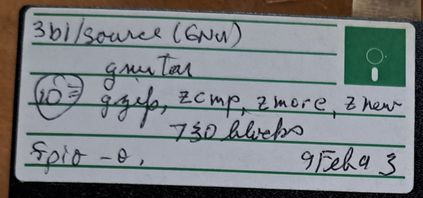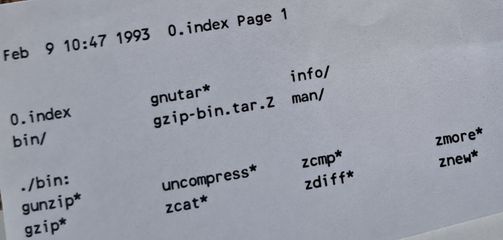- SAP Community
- Groups
- Interest Groups
- Open Source
- Discussions
- Information spelunking - When you must read the so...
- Subscribe to RSS Feed
- Mark Topic as New
- Mark Topic as Read
- Float this Topic for Current User
- Bookmark
- Subscribe
- Mute
- Printer Friendly Page
Information spelunking - When you must read the source, Luc.
- Mark as New
- Bookmark
- Subscribe
- Mute
- Subscribe to RSS Feed
- Permalink
- Report Inappropriate Content
a month ago
A few weeks ago I related a work-flow tale that had a partial germ in a stack of (blank) punch cards from early IT days with the title "information archeology". Then a week ago an open source integrity issue appeared in the news as an intrusion in a common archive protocol repository. Meanwhile, as I continued digging through an accumulation of magnetic media I noticed a backup protocol I had not seen before.
Amidst other standard "DOS format" floppies from the 1990s, a set like the one pictured here were hand-labelled with the contents, and the storage method, cryptically written as "fpio -0.".
The author used GNU tar, on an AT&T UNIX system, but instead of tar used in the literal sense of a tape archive, The first line says "3b1/source (gnu)" which looked a bit like a Usenet group as the provenance for the origin of the code. Except the paper listing indicates what was stored were primarily compiled binaries, not source text (not the "*" below indicating executable).
In the top level directory, there is a UNIX compressed (not GNU gz'd) archive file called "gzip-bin.tar.Z" and an executable named gnutar. The only other file at the root is "0.index" which is what the printout shows (highly probably).
In the ./bin directory are compress/uncompress utilities from the open source GNU project. Hopefully you will guess why there is gzip and gunzip, but only uncompress, not compress. There may be no files in either info/ or man/.
My earliest recollection of "production" backup to tape protocols was whether one would use the (a) tape archive tools, or (b) the cpio alternative, with the difference attributable to "this one comes from Bell Labs in New Jersey" and "this one comes from Berkeley, California." I had not heard the method of treating a floppy disk like a single-stream write/read cycle, like the reel-to-reel mag tapes you see in 60's spy movies, because the commonly adopted schemes were random or direct I/O instead.
"cpio" standing for Copy In Out, my favorite set of options had the mnemonic "poodle move" but was spelled "-pdlmuv" that worked best. Could we read an fpio-formatted disk these days? Stay tuned...
- SAP Managed Tags:
- Open Source
- Labels:
-
archive
-
code repository

